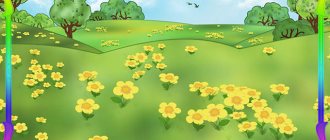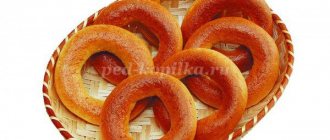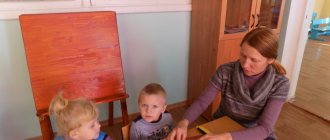Excursion to the mini-museum “Ecosystem “Forest” in the second junior group.
Summary of the excursion to the mini-museum “Ecosystem LES”
in the middle group No. 1
Tasks:
Social and communicative development:
promote the development of communication and interaction of the child with adults and peers; formation of readiness for joint activities with peers, the foundations of safe behavior in nature.
Cognitive
development
: formation of children's cognitive interests, curiosity and cognitive motivation; cognitive actions, the formation of primary ideas about the objects of the surrounding world (the ecological system of the Forest), about the features of the native nature; development of imagination and creative activity.
Speech
development: update the active dictionary; development of coherent, grammatically correct dialogical and monologue speech.
Artistic and aesthetic
development: formation of prerequisites for value-semantic perception and understanding, aesthetic attitude towards nature; perception of fiction about the forest and its inhabitants; implementation of independent creative constructive and modeling activities of children when playing with models.
Physical
development: acquiring experience in children’s motor activity.
At the entrance to the museum, children are greeted by a white bunny. He invites the children to visit
.
Hare. Guys, tell me why am I white?
Children (There is still a lot of snow, it’s cold)
Hare. Do you know what hares eat in the forest in winter?
Children. Tree bark
Hare. I invite you to the forest. We placed trees in our forest. What trees can you find in the forest?
Children. (Spruce, pine, birch).
Hall 1
.
Environmental campaign “Save the Christmas tree”
There are many different Christmas trees in our museum. On New Year's Eve, trees are cut down. What do you think, is it necessary to cut down the forest beauty? What can replace the Christmas tree? Why are we doing this?
Children. You can make different Christmas trees for the holiday with your own hands.
Hare. These are how beautiful our Christmas trees are. Made of mesh, knitted, Christmas tree with friends, made of cotton pads, made of wood. The children and their parents made them for us. Did you like them?
Children. Yes
Hare Next New Year, you and your mothers will make the most beautiful Christmas tree with your own hands. With this you will save the forest beauties.
Hall 2.
Large hall “Ecosystem LES”
Here we look at trees, find similarities between trees and their differences. Let's find out who needs trees in the forest. What floors are there in the forest and who lives on them. How many bears are there in our forest? Bunnies? Foxes? Right. Here we act out fairy tales about animals.
Hare. And here we collected the gifts of the forest. Look at the exhibits, here is the white bark with stripes. Whose bark is this? (Birch trees) And this dark bark? (Poplar)
Hare. There are cones in our museum. They are different, some are prickly, others are smooth. (Hand out the cones). Pick up the big bump, pick up the little bump. Different trees have different cones. There are a lot of nuts in pine cones. They are tasty, nutritious, and contain a lot of vitamins.
Hare. But on this shelf there are collected wood products. Pencils, houses, toys, paper crafts, big chicken (origami), sandals.
Look at our books about the forest, they have large and bright pictures.
Game "Tree"
introduces us to changes in nature and in the life of trees. There are roots, branches, a hollow. Who lives in a hollow? There are holes near the tree. Who lives in minks?
Children. Foxes live in minks, hedgehogs sleep in winter, and a bear sleeps in a den.
Educator: Do animals need trees?
Didactic game “Who eats what?”
Educator: And here we have a very interesting game. It's called "Who's Eating Whom?" (Food chains). I take the grass, put it on the table, spikelets have grown in the grass, who eats the spikelets and seeds? (Mouse). Who eats mice? Guess, a big bird, round eyes, sleeps during the day, flies at night, catches mice. Who is she? (Owl)
The chain “grass, spikelet, mouse, owl” is disassembled
Does the owl need grass? (No) What about the spikelets? (No) Can mice live without grass? (No) They all need each other. One cannot live without the other.
It is explained that the owl also needs grass in the field, that in nature everything is interconnected.
Bottom line.
Hare. Did you like our museum? (Children's answers) Will you come to visit us in our museum?
We will be very glad to see you. And now I’ll run and tell everyone in the forest about how great you are. The days will be warm soon, it’s time for me to change my fur coat.
Excursion progress
The teacher draws the children's attention to the kindergarten . It's two stories high. The kindergarten is very large . It has 2 main entrances. in the kindergarten . This is because there are many groups and different rooms . The teacher shows the children the windows of their group .
Around the building there are flower beds with beautiful and bright flowers. There are many large trees in the garden In summer they protect children from the sun.
On the territory of the kindergarten there are many areas with various buildings: sandboxes, houses, cars, ships, buses, swings, benches and benches. Adults did all this for children because they love children and care about them. Everything made by human hands must be protected.
Together with the children, the teacher examines the plants on the site, flower beds, and a vegetable garden. He asks the children why there are so many trees and bushes here. It reminds me that all this was planted by adults to make the site beautiful, that they took care of the children.
The teacher explains that there are a lot of kindergartens , in each kindergarten adults plant many different plants, and our streets become very beautiful.
The teacher invites the children to remember the name of the street on which the kindergarten . He asks what plants are planted there and asks to name them.
1. On what street is our kindergarten ?
2. What did you see on the way to the site?
3. What grows on our site?
4. What was built on the site?
5. Why is it forbidden to destroy buildings or tear up plants?
Improvement of the territory of the kindergarten It is not without reason that the kindergarten is called the second home for preschool children. Here kids spend most of their day, here they develop, communicate,...
Summary of the didactic game “Who works in kindergarten?” (name of professions of kindergarten workers) (junior group) Goal: to deepen and clarify children’s ideas about kindergarten. To consolidate knowledge of the names of professions of kindergarten employees. Bring up.
Abstract of the educational activity “Acquaintance with the premises of the kindergarten (music and physical education hall)” (junior group) Purpose: to teach children to navigate some of the premises of the kindergarten (music hall, physical education hall). Cultivate kindness.
Plan-Consect Tour of the kindergarten “Who takes care of us?” (Junior group)
Municipal preschool educational institution
"Kindergarten No. 104" of the city of Yaroslavl
Tour of the kindergarten “Who cares about us?”
Educator Goruleva E.N.
1.
Develop knowledge about your kindergarten, the ability to navigate some of the premises of the preschool institution; cultivate a friendly attitude, respect for preschool employees, neatness, and careful handling of objects;
2. Expand children’s understanding of the adult world and awaken interest in their professional activities. Recognize and call kindergarten employees by name and patronymic;
3. To develop respect for the work of kindergarten employees (teacher, assistant teacher, cook, nurse, wardrobe maid, carpenter);
4. Enrich your vocabulary with verbs: teach, study, cook, fry, bake, wash, treat, cook, sew, wash, iron, care, repair, plan, saw, etc.)
Planned results for the development of integrative qualities of children:
answer the teacher’s questions, participate in conversations during a tour of the kindergarten, get acquainted with some professions, and have the simplest skills of organized behavior in kindergarten.
Materials and equipment:
letter inviting you to a tour of the kindergarten.
Conversations about professions using visual aids;
Role-playing games: “Kindergarten”, “Family”, “Hospital”;
Reading fiction: “All works are good”, “I’m going to kindergarten”, etc.
Telling your parents about your place of work.
Contents of organized children's activities
The teacher reads to the children a letter from the kindergarten staff, who invite them to a tour of the kindergarten, reminds the children how to behave when visiting (modestly, do not shout, politely greet the owners, thank them for the invitation, etc.). Offers to go on a journey through the kindergarten.
Journey through the kindergarten:
We will begin our journey with our group. Which child will correctly say who I work for? ( Educator
).
What do I (the teacher) do throughout the day? ( Children's answers
).
That's right: meets, feeds, clothes, teaches, educates, helps, cares, plays, reads, conducts classes, holds holidays.
What kind of teacher ( Caring, kind, smart, attentive, loving
)
Poems about the teacher
Mom goes to work. And dad has a lot to do. So we need someone to look after us!
Who will feed us porridge from a spoon, Who will read us a fairy tale, Who will put on our boots, Who knows poems and songs?
Who will make peace, who will tell me, Well, of course, the teacher!
Profession teacher assistant (nanny)
Let's now see who else cares about us in our group? ( Teacher's assistant, nanny) (Children say name)
What does a teacher's assistant do? ( Children's answers
)
Washes the dishes, the floor, wipes the dust, helps with dressing, brings breakfast, lunch and dinner from the kitchen, takes care. What kind of nanny do we have? ( Kind, caring, hardworking)
Poems about a teacher's assistant
A good word is “helper”: Helps to assemble the toys, Helps the kids undress, Quietly puts them to bed.
From clear dawn until dark, she is in our kindergarten. Who will bring us lunch and tidy up the dishes? Our group is no more beautiful. Clean and bright all around! Maybe our nanny has not two, but ten hands?
Now let's start our journey through the kindergarten.
Look, this is our wardrobe maid's office. Do you see the sign?
Our housekeeper's name is Galina Vasilievna. What is she doing?
There is a sewing machine by the window, which means she is sewing. And here is the ironing board and iron. Why is this necessary? ( Children's answers
).
Galina Vasilievna irons bed linen, aprons, bathrobes, tablecloths, stores and issues clothes, keeps records of linen, and is responsible for washing and cleaning them. What kind of lady do we have? ( Thrifty, clean, hardworking, responsible, skillful, caring).
How can you help her? (Wash your hands after a walk to avoid staining your towels).
Let's look into another room. Here we see a large bathtub and washing machines. Why is this necessary? ( Children's answers
).
Summary of the excursion “Journey through the kindergarten” for children of primary preschool age 3-4 years
Summary of the excursion “A Journey through Kindergarten”
for children of primary preschool age 3-4 years old
Develop interest in the work of adults.
Educational:
Strengthen children's knowledge about the workplace of preschool employees. Teach children to formulate a question.
Developmental
: Develop active verbal communication skills, teach children to value the work and care of adults, apply the acquired knowledge in productive and other activities.
Educational
: To instill in children a respectful attitude towards kindergarten staff and their work.
Conversation with children “Who takes care of us?”, looking at illustrations of “Professions”, an evening of riddles and guesses.
Plan for employees to talk about their activities.
What kind of work does it do?
What kind of headdress does he wear?
Tools he uses?
Course of the excursion (in a group):
Educator:
You know that many adults work in kindergarten. They take care of you, try to make you feel good, happy and comfortable. And our first and most important assistant is the junior teacher. What's his name? What is she doing? (Children's answers.) The junior teacher's story about his activities (according to the proposed plan).
Educator:
What are the names of your teachers? What are they doing? (Children's answers). The teacher's story about his activities.
Educator:
Do you want to meet and find out who else works in kindergarten? Let's go on a trip. What will we go on? (Children's suggestions).
By train. Take your seats in the carriages. (Here our train is moving, the wheels are knocking.....)
Educator:
The very first office is an office in which adults in white coats work. “Who works here?” (Children's answers).
Educator:
That's right - a doctor and a nurse. Shall we meet them? And now I’ll ask the adults: “What’s your name?” (Answers from adults)
Educator:
Ask, Dasha. (What is your name?) (Answers from adults).
Educator:
Tell us about your profession. Adults talk about their activities. Thank you very much. And the guys and I will move on. Take your seats in the carriages. The journey continues.
Educator:
What kind of office is this? Look, there are also adults in white coats here. Maybe this is also a medical office? (Children's answers).
Educator:
Correctly called FOOTER BLOCK. There are many rooms here. Before entering, we need to put on overalls. (We put on aprons, scarves, and caps for children). How many adults work? (A lot of). What is the name of the profession of these adults? (Children's answers). What do you want to know from chefs? (Children's questions)
Educator:
Thank you very much. And we continue our journey. Zinaida Romanovna meets us. What is she doing? (Children's answers). Name the laundry assistants. (Iron...) The washerwoman’s story about her activities.
Educator:
Thank you very much. And we need to return to the group. How can you quickly get to the group? (By plane). Take your seats. We start the engine. Let's fly.
Educator:
Did you enjoy traveling? Do you want to know who works in kindergarten? Next time we will find out who is the most important person in our kindergarten and what he does.



